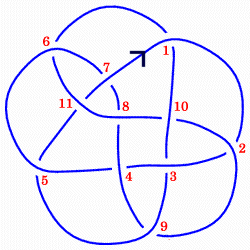Gauss Notation
Notations are developed to describe knot diagrams succinctly and usefully. The goal is to encode the knot diagram in a way that enables someone else to reconstruct an equivalent diagram from the code.
 The Gauss code for knot diagrams is perhaps the
easiest to describe. Suppose we have a diagram for some oriented
knot. Arbitrarily, pick a point P on the knot that is not on a
crossing. Then follow the orientation of the knot to arrive at the
first crossing, and label it 1. Then, follow the strand to the next
crossing. If the crossing you arrive at is not already labeled, then
label it 2 (i.e. one greater the crossing you last labeled). Otherwise,
skip this crossing and proceed to the next one. Repeat this procedure
until all the crossings are labeled once.
The Gauss code for knot diagrams is perhaps the
easiest to describe. Suppose we have a diagram for some oriented
knot. Arbitrarily, pick a point P on the knot that is not on a
crossing. Then follow the orientation of the knot to arrive at the
first crossing, and label it 1. Then, follow the strand to the next
crossing. If the crossing you arrive at is not already labeled, then
label it 2 (i.e. one greater the crossing you last labeled). Otherwise,
skip this crossing and proceed to the next one. Repeat this procedure
until all the crossings are labeled once.
Given this labeling of the crossings, the notation is derived by walking the knot again, starting at P. As we follow the knot, we record the crossings we encounter, keeping in mind that if we happen to traverse a crossing by an under-crossing strand, then we record the label of the crossing with a negative sign. The procedure continues until we come back to P. For 12 crossing knots, a second sign convention is used: if the crossing is right handed, it is given a positive sign; if it is left handed, a negative sign.
For the example diagram, the Gauss code will be:
1 -2 3 -4 5 6 -7 -8 4 -9 2 -10 8 11 -6 -1 10 -3 9
-5 -11 7Extended Gauss Code
In general, the Gauss Code for a knot diagram cannot be used to reconstruct an equivalent diagram, but a minor revision of the notation will make the reconstruction possible. The revision is called the Extended Gauss Code.
The crossings are labeled as before, but when recording the labels, the rules for assigning signs are slightly different. The first time we encounter a given crossing, we do as before: over-crossing is positive, under-crossing is negative. The second time we encounter a crossing, we assign a sign depending on the handedness of the crossing. If it is right-handed, we assign positive; if it is left-handed, negative.
Therefore, for the example, the Extended Gauss Code will be:
1 -2 3 -4 5 6 -7 -8 -4 -9
-2 -10 8 11
>6 -1 -10 3 9 -5 -11 -7 The numbers in red encode the handedness of the crossings.